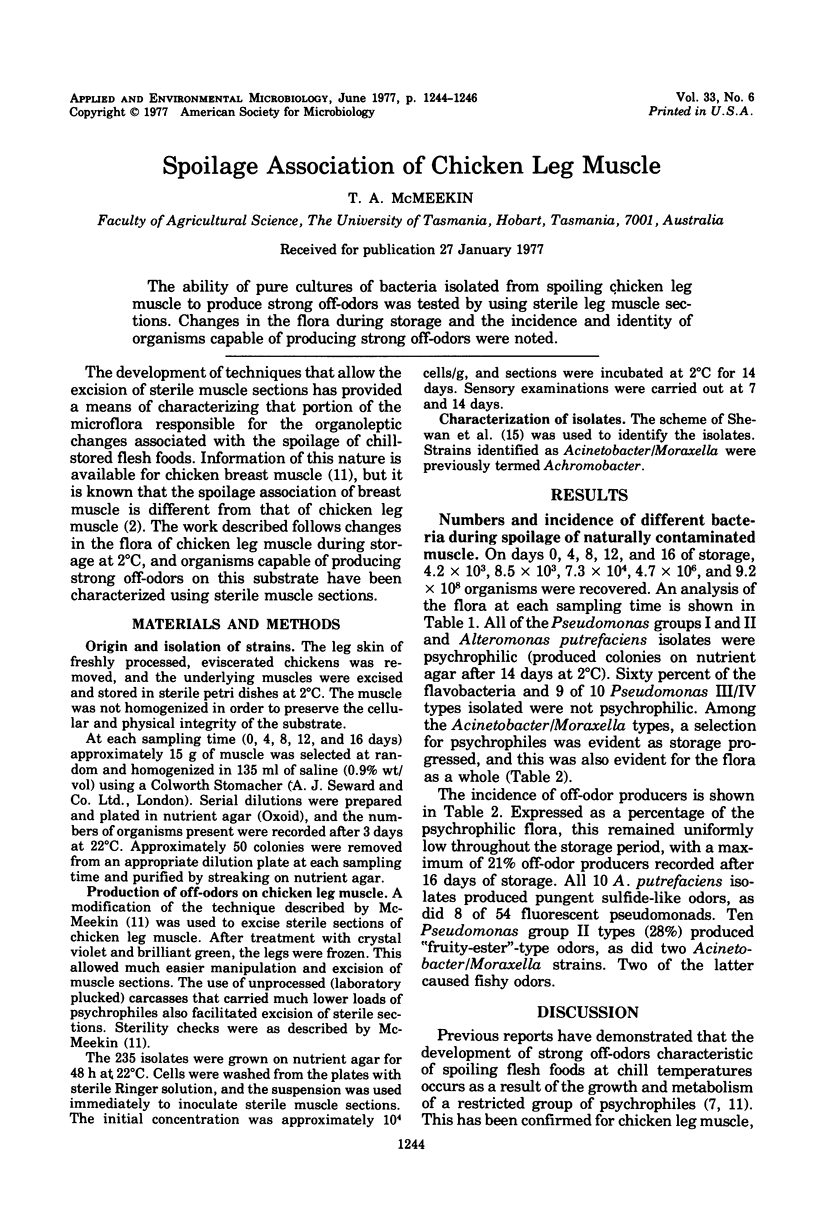Abstract
The ability of pure cultures of bacteria isolated from spoiling chicken leg muscle to produce strong off-odors was tested by using sterile leg muscle sections. Changes in the flora during storage and the incidence and identity of organisms capable of producing strong off-odors were noted.
Full text
PDF


Selected References
These references are in PubMed. This may not be the complete list of references from this article.
- ADAMS R., FARBER L., LERKE P. BACTERIOLOGY OF SPOILAGE OF FISH MUSCLE. II. INCIDENCE OF SPOILERS DURING SPOILAGE. Appl Microbiol. 1964 May;12:277–279. doi: 10.1128/am.12.3.277-279.1964. [DOI] [PMC free article] [PubMed] [Google Scholar]
- Barnes E. M., Impey C. S. Psychrophilic spoilage bacteria of poultry. J Appl Bacteriol. 1968 Mar;31(1):97–107. doi: 10.1111/j.1365-2672.1968.tb00345.x. [DOI] [PubMed] [Google Scholar]
- Chai T., Chen C., Rosen A., Levin R. E. Detection and incidence of specific species of spoilage bacteria on fish. II. Relative incidence of Pseudomonas putrefaciens and fluorescent pseudomonads on haddock fillets. Appl Microbiol. 1968 Nov;16(11):1738–1741. doi: 10.1128/am.16.11.1738-1741.1968. [DOI] [PMC free article] [PubMed] [Google Scholar]
- Gardner G. A., Patterson R. L. A proteus inconstans which produces 'cabbage odour' in the spoilage of vacuum-packed sliced bacon. J Appl Bacteriol. 1975 Dec;39(3):263–271. doi: 10.1111/j.1365-2672.1975.tb00571.x. [DOI] [PubMed] [Google Scholar]
- Herbert R. A., Hendrie M. S., Gibson D. M., Shewan J. M. Symposium on microbial changes in foods. Bacteria active in the spoilage of certain sea foods. J Appl Bacteriol. 1971 Mar;34(1):41–50. doi: 10.1111/j.1365-2672.1971.tb02267.x. [DOI] [PubMed] [Google Scholar]
- Lapin R. M., Koburger J. A. Hydrogen sulfide production by Pseudomonas putrefaciens in shrimp experimentally packed in nitrogen. Appl Microbiol. 1974 Apr;27(4):666–670. doi: 10.1128/am.27.4.666-670.1974. [DOI] [PMC free article] [PubMed] [Google Scholar]
- Levin R. E. Detection and incidence of specific species of spoilage bacteria on fish. I. Methodology. Appl Microbiol. 1968 Nov;16(11):1734–1737. doi: 10.1128/am.16.11.1734-1737.1968. [DOI] [PMC free article] [PubMed] [Google Scholar]
- McMeekin T. A., Patterson J. T. Characterization of hydrogen sulfide-producing bacteria isolated from meat and poultry plants. Appl Microbiol. 1975 Feb;29(2):165–169. doi: 10.1128/am.29.2.165-169.1975. [DOI] [PMC free article] [PubMed] [Google Scholar]
- McMeekin T. A. Spoilage association of chicken breast muscle. Appl Microbiol. 1975 Jan;29(1):44–47. doi: 10.1128/am.29.1.44-47.1975. [DOI] [PMC free article] [PubMed] [Google Scholar]
- Miller A., 3rd, Scanlan R. A., Lee J. S., Libbey L. M. Volatile compounds produced in sterile fish muscle (Sebastes melanops) by Pseudomonas putrefaciens, Pseudomonas fluorescens, and an Achromobacter species. Appl Microbiol. 1973 Jul;26(1):18–21. doi: 10.1128/am.26.1.18-21.1973. [DOI] [PMC free article] [PubMed] [Google Scholar]
- Nicol D. J., Shaw M. K., Ledward D. A. Hydrogen sulfide production by bacteria and sulfmyoglobin formation in prepacked chilled beef. Appl Microbiol. 1970 Jun;19(6):937–939. doi: 10.1128/am.19.6.937-939.1970. [DOI] [PMC free article] [PubMed] [Google Scholar]


